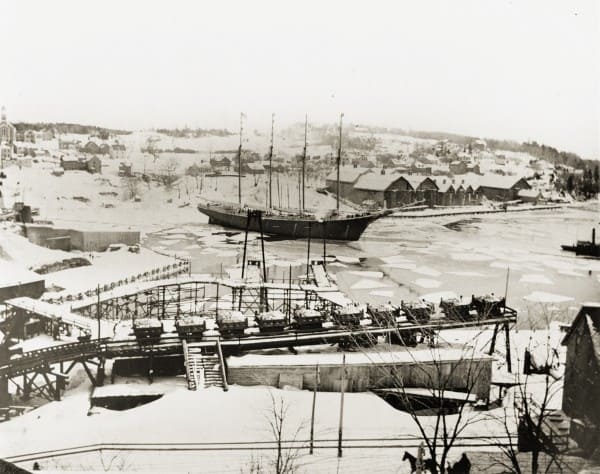Camden Public Library, each year, displays photos from Penobscot Marine Museum‘s archives that show what mid-coast Maine’s waterfront was like in years’ past. The latest exhibit gives a glimpse into the Ed Coffin collection: 30 albums of images he collected since moving to Owls Head over 65 years ago and donated last fall to PMM. The show runs to the end of April and if you can get to Camden, don’t miss it. But if you can’t make it, here’s a sampling graciously made available to OffCenterHarbor by the museum. (Scanning and cataloging of the Coffin collection is ongoing, so it’s not yet online. But many others are, and to view them, check here.)
The stories that go with these photos are important, so if you have information to add, by all means do so. Just leave a reply (in the space at the bottom of this page) and we’ll see that it gets back to PMM where the staff there can digest and post it.
Icy Harbor, Rockport, Maine. Four-masted schooner WINFRED S. SCHUSTER, her sails bent on and covered, is about to be towed through the ice of Rockport’s harbor in the winter of 1904. On shore in the foreground, dump carts loaded with quarried limerock stand by to feed the kilns below them. Lined up across te harbor are ice houses used to store ice cut from Lily Pond.(LB2013.21.151)
. . . sign up to the right to get immediate access to this full post,
plus you'll get 10 of our best videos for free.
Get Free Videos& Learn More Join Now!!for Full Access Members Sign In



Ben Fuller says:
Ed collected his photos from many sources and unfortunately didn’t let us know from whence . We have the negatives of some of these but doing a match up will be challenging.
David Tew says:
Just as ice chutes delivered ice from ice houses to waiting schooners for shipment south, I wonder if temporary ice chutes skidded ice blocks from Rockport’s Lily Pond to the shoreside ice houses for storage.
gerald fellows says:
great photo lets see more
David Tew says:
Maynard,
Who do I contact at the PMM to find that East Boothbay (or Boothbay Harbor) scene again? I forgot the person’s name. He gave the talk and slideshow at the Camden library.
Kevin Johnson says:
For questions about our collections email me or my helper Matt Wheeler (who gave the talk in Camden) or call us at 548-2529 ext. 210
Kevin Johnson
Photo Archivist
kjohnson@pmm-maine.org
Matt Wheeler
Photo Archivist
Mwheeler@pmm-maine.org
Ted Lameyer says:
Maynard,
Great photos. The details in these historic photos are so telling and help demystify the time period. I particularly liked the house on the barge. It answers the questions I had about how that was done. I am always shocked by the frozen harbors of yesteryear, as I have heard talk of ice covered Penobscot Bay from Castine to Belfast in 1895, but I could not imagine that today. (Another pictorial argument of global warming from the industrial revolution to today)